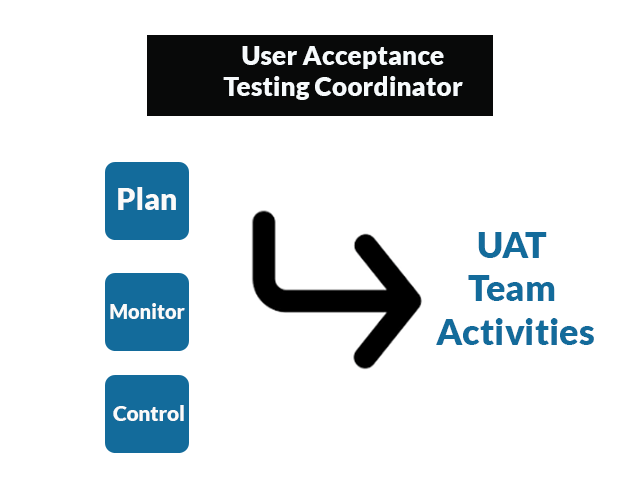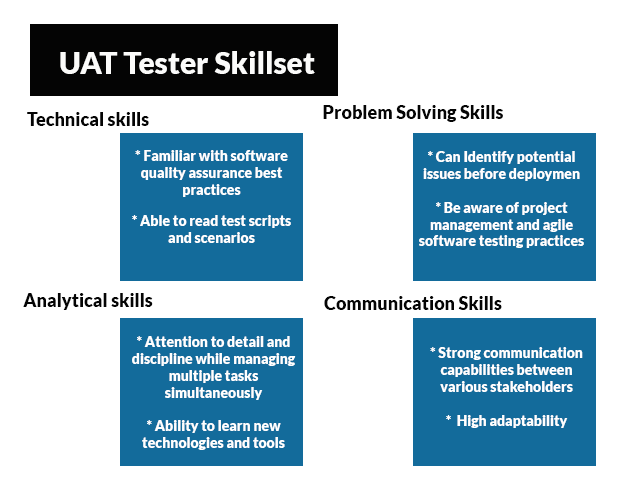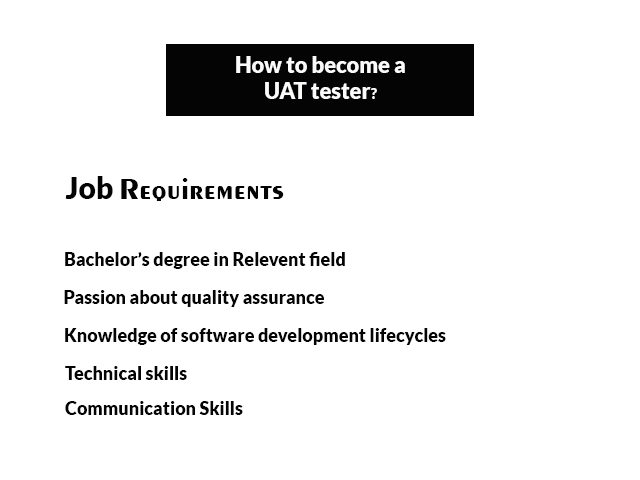Are you a software developer or a QA engineer looking to move into user acceptance testing uat? UAT Testers, also known as User Acceptance Testers or UAT Analysts, are responsible for ensuring that software meets the needs of its users. Here is an article about what is a UAT Tester and their roles and responsibilities.
What is User Acceptance Testing?
Understanding the role of the UAT tester means we must know what User Acceptance Testing UAT is.
Briefly, a User Acceptance Test is the last round of testing a newly developed product, whether it be software, an application, or a device. It is the process of confirming a system satisfies the business and technical user requirements and ensures the system is suitable for use.
In other words, end-users can evaluate the program using real-world scenarios to validate that the system achieves the most critical software project procedures it was supposed to do. UAT usually takes place after the system has gone through various levels of testing:
- Unit Testing
- Integration Testing
- System Testing
UAT Testers are in the testing phases to ensure the system meets their needs and expectations.
Here is an article link for UAT Ultimate Guide.
What is a UAT Tester?


UAT testers are integral to the product creation process and are charged with a broad range of duties. They have an important mission of ensuring that all new programs and systems function without issues so users can take full advantage of their features. They are the unsung heroes behind software implementation.
In the final stage of the software development life cycle, they ensure that the final users’ quality of the application or product is ready for use. They work with developers to find bugs or related issues and then report them back to the developers so they can be fixed before the software goes live.
- A UAT tester is needed when the completed software, program, or website is ready to be launched to the public.
- They effectively act as beta testers, trying out all functionalities at least once.
- Going over all of the conceivable test scenarios while utilizing them.
UAT testers help ensure successful outcomes for both developers and users alike.
Tell me the roles of a UAT Tester


UAT Test Manager
The UAT Test Manager has overall responsibility for the User Acceptance Testing process. Their responsibilities include all aspects of test management, from managing test case creation running the test cases, reporting the results, and resolving issues during testing.
- Responsible for creating and managing all UAT documents, release notes, and baselining rules.
- Oversees the overall planning and execution of the UAT process.
- Accountable for ensuring that each test case is complete, accurate, and up-to-date.
- Responsible for ensuring the UAT scope includes all the appropriate information.
- Monitors how testing progresses and makes necessary changes.
- Responsible for making sure the product is ready before it’s released.
User Acceptance Testing Coordinator


The UAT acceptance test coordinator is in charge of all UAT team activities. Their tasks include planning, monitoring, and controlling. It is part of their job to support the end-users’ testing process and assist the business users with customized system testing.
UAT Testing Business Analysts
The UAT Testing Business Analyst is responsible for creating UAT test cases, including the requirements and conditions for each. This includes defining what needs testing in each situation, choosing the correct test data, and reporting how the tests went.
- Create test cases based on UAT requirements.
- Researches test data and create or manages the UAT test cases.
- Verifies any changes to existing information and ensures that all necessary data is available.
- Creates or manages any baselining rules needed for the product.
- Ensures the test cases are complete, accurate, and up-to-date.
- Communicate changes to the User Acceptance Testing (UAT) scope to all stakeholders.
Responsibilities of a UAT Tester
A UAT tester is a critical member of the development team and has an expansive task list that includes the following:
- running tests on individual components
- conducting end-to-end regression testing and tracking down bugs
- validating application functionality and usability,
- discovering defects in code or design flaws before launch,
- creating test cases and test scenarios
- coordinating test execution and test resources on various platforms with different devices
- executing effective tests based on project and product manager input,
- Working closely with project managers or product owners to discuss project status and any [potential] issues that may arise
- documents UAT results and provide daily or weekly status report for progress
- And providing feedback on project performance.
- UAT testers are responsible for planning and controlling tests, ensuring they are within budget and on deadline.
- They also create test plan/s, test profiles and concepts, coordinate test cases, and document results.
- Note any successful past use cases in order to improve current and future test outcomes.
- develop testing programs, test data, test cases, and UAT test plans
- Create Execute UAT tests and log any issues found
Ultimately, UAT Tester strives to make each program as problem-free as possible and to guarantee optimal performance when released.
What skills does a UAT Tester need?


For successful UAT testing, the tester needs to possess a wide range of skills.
A UAT tester needs the right combination of technical and analytical proficiency and problem-solving capabilities. Here is a breakdown of the skills that a UAT Tester has to have.
Technical Skills:
- Familiar with software quality assurance best practices such as debugging, security analysis, etc.;
- Being able to read test scripts and scenarios is a valuable skill – it can give you the information needed to perform effective tests on software products, ensuring they’re fit for user use.
- Understands the development life cycle and project management processes.
- Can automate and write tests
- Can do manual testing
Analytical Skills:
- Attention to detail and discipline while managing multiple tasks simultaneously – all of which allow for smooth sailing from the development phase into production mode!
- The ability to comprehend technical/business requirements and specifications.
- Ability to learn new technologies and tools
Problem-Solving Skills:
- Identify potential issues before deployment into production environments.
- Be aware of project management and agile software testing practices that work best
Communication Skills
- strong communication capabilities between various stakeholders, including developers, system administrators, and clients.
- High adaptability
There should also be the ability for the software quality assurance tester to be spontaneous in their reporting, have proper documentation skills, and also be good at managing their time.
How to become a UAT tester-Job Requirements


If you love quality assurance and have a good understanding of software development, a UAT tester career might be right for you.
To qualify, you should possess both technical skills (e.g., programming experience in various coding languages) and interpersonal competencies needed to work closely with cross-functional teams on testing projects.
Additionally, prospective testers must demonstrate strong communication abilities to articulate acceptance criteria while remaining detail-oriented enough to identify issues throughout their process execution within given timelines.
You will need to have a foundation of technical knowledge, which you can acquire through formal classroom training or on-the-job experience. User acceptance testing certifications can also be beneficial to demonstrate your UAT skills and knowledge.
Once you have the UAT tester job qualifications, you can apply for UAT testing jobs with organizations that need quality assurance experts. UAT testers can also pursue UAT career growth opportunities through applying for UAT jobs within larger organizations with multiple development teams.
UAT Tester Challenges


A UAT tester may face many challenges throughout the UAT process. These range from project scope changes to limited testing resources and miscommunication between stakeholders, which can all result in a UAT failure or delay.
A UAT tester needs to meet tight deadlines while ensuring user requirements are met to avoid misunderstandings and issues during the UAT phase.
Hence, he or she must remain organized, flexible, and constantly on their toes while managing UAT tasks proactively.
The UAT and UAT test plans’ effectiveness depends on customer selection. Thus, the initial UAT testers should be internal users, as they need to know enough about what the system does and how it works. Although you can bring people in from outside to do this testing, there is often a high cost involved—and few companies want to run that risk because UAT is an important test.
Whether the testers are internal or external, the information received from these clients is beneficial. The client feedback can identify problems with the existing system and gather business requirements for future enhancements among the software development team.
Isolate application from the developers


Testing is also prone to mistakes when there is too much involvement from developers. To avoid this, companies should isolate the application from the developers and have a separate platform for testers to run their tests. By doing this, you will be able to spot any issues quickly and maintain proper documentation.
Programmers should not write tests
Wrongly written tests can have a negative impact on the process of software development. Programmers should not write tests as they may lack the necessary skills to accurately test and debug code. Their bias may also cause them to miss key areas that need attention. Moreover, programmers focus on finishing tasks quickly.
Accumulating a skilled software tester with the required analytical skills, and can find out the root cause of problems quickly, is very important for successful software testing. To ensure that testers possess these attributes, companies can conduct professional certifications and tests to select their testers from the pool of applicants.
UAT Tester Trends
Growth of Automated Testing
Automated UAT testing is the latest trend in user acceptance tests. Automation frameworks like Selenium, Robotium, and UFT (formerly QTP) are becoming more popular UAT testing tools.
Agile Development
UAT testing is being done more agilely, occurring during each iteration. UAT testers are expected to be more involved in the development process and understand the UAT process.
Use of Virtual Teams
UAT testing is being done with distributed teams, which has its own set of challenges. A UAT tester needs to ensure that all members of the UAT team are on the same page and understand the UAT process. He or she also needs to be able to work remotely to collaborate with UAT teams in different countries and should be familiar with various collaboration tools such as Skype, Slack, and Jira.
Why RUN UAT?
Having UAT is important because it helps identify issues in the software before it goes live. It can prevent costly rollbacks and improve the user experience. Testing results can be used as evidence that the software has been tested and approved for release.
UAT should even be conducted and documented as part of the Quality Assurance process in software development and involve user feedback from both internal and external stakeholders.
UAT processes help identify potential user issues in a timely fashion, which can enable developers to improve the product before launch.
Are UAT and QA the same?
QA focuses on testing the product to confirm it has no issues. In comparison, User Acceptance Testing ensures that it meets required standards and is ready for use. UAT is done after product development but before it’s released, while QA is carried out during the product’s development to ensure no issues before it’s released. Quality assurance is about finding problems, while user acceptance testing ensures the product meets the requirements.
Conclusion
Whether a manual testing UAT tester or an automated UAT tester, UAT testers have a critical role in the software development life cycle. We hope this article has helped you better understand how to perform user acceptance testing and UAT testers’ role in software development. If you are up to finding jobs on UAT tester, hopefully, this helped.

